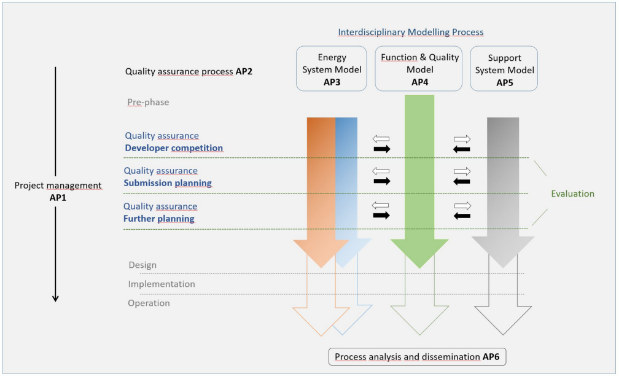QualitySysVillab - Protecting sustainable qualities in neighbourhood developments through process control and new digital methods
Short Description
Starting point / motivation
Cities and municipalities play a central role in climate protection. The innovative, integral planning and construction of sustainable city districts has therefore become an indispensable key element of future-oriented, urban development. Countless urban development concepts, strategies and vision documents testify to the central importance of achieving this goal.
The built reality, however, only lives up to this claim in a few cases. This is due, among other things, to the lack of continuous, practical monitoring to ensure sustainable qualities, as well as seamless and interdisciplinary digital modelling of the development disciplines involved.
Contents and goals
Quantitative definition and integration of sustainable qualities in district development as early as possible, with the help of suitable digital models and process control methods that can be used in reality, is therefore of crucial importance. However, these integral methods and models must first be (further) developed in order to find their way into the everyday neighbourhood and building development process.
The aim of this research project is to develop an innovative process concept in combination with new digital methods and to test it in a case study. The focus is on bringing energy efficiency, renewable energy supply, material efficiency and other functional and sustainable qualities from the level of intention and announcement to the built reality.
Methods
Based on a novel, structured approach, stakeholders are involved in a timely and transparent manner, targets are agreed upon and their achievement is evaluated several times during the process. The process model includes project developers, public administration, energy suppliers, property developers, process management and sustainability assessment.
A 3D CAD Urban Information Model is being built as a central, digital overall model to collect, process and evaluate data in a semi-automated way. For this purpose, digital methods from the fields of energy, structural planning and urban development are being further developed and linked with each other in order to be able to quantify, document and visualise targets (Figure 1).
Expected results
The project partners in the QualitySysVillab project, ÖBB as a Klimaaktiv partner, the City of Villach as a climate pioneer partner of the Climate Ministry, as well as the Graz University of Technology (Climate Neutral TU Graz project) are pursuing ambitious climate goals and are working on solutions at three levels of action in the present project:
- Integrative process control model to ensure sustainable qualities in district development
- Urban Information Model as a central, digital overall data model for energy and structure
- Real life test in the case study Innovation District Villach Westbahnhof (Figure 2)
The results and insights gained from the case study Innovation District Villach Westbahnhof will subsequently serve as a multiplier to be transferred to future district developments in Villach and ÖBB-Infrastruktur AG.
Project Partners
Project management
Institute of Thermal Engineering, Graz University of Technology
Project or cooperation partners
- ÖBB-Infrastruktur AG
- KELAG Energie & Wärme GmbH
- Stadt Villach
- Institut für Betonbau, TU Graz
- Ernst RAINER Büro für resiliente Raum- und Stadtentwicklung e.U.
- Resource Management Agency
- smartwärts e.U.
Contact Address
Institute of Thermal Engineering
Graz University of Technology
Thomas Mach
Inffeldgasse 25b
A-8010 Graz
E-mail: thomas.mach@tugraz.at
Web: www.iwt.tugraz.at


